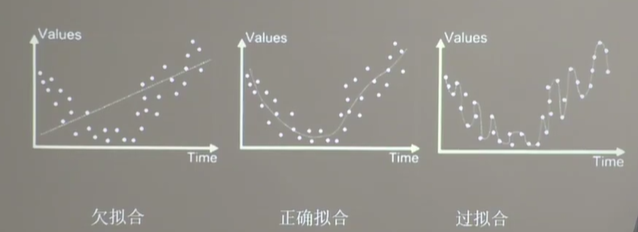欠拟合:对现有数据学习不够彻底
过拟合:模型对当前数据拟合的太好,而对从未见过的新数据无法做出正确判断,模型缺乏泛化力。

缓解欠拟合:增加输入特征项,增加网络参数,减少正则化参数
缓解欠拟合:数据清洗,增大训练集,采用正则化,增大正则化参数
# 导入所需模块 import tensorflow as tf from matplotlib import pyplot as plt import numpy as np import pandas as pd # 读入数据/标签 生成x_train y_train df = pd.read_csv('dot.csv') x_data = np.array(df[['x1', 'x2']]) y_data = np.array(df['y_c']) x_train = x_data y_train = y_data.reshape(-1, 1) Y_c = [['red' if y else 'blue'] for y in y_train] # 转换x的数据类型,否则后面矩阵相乘时会因数据类型问题报错 x_train = tf.cast(x_train, tf.float32) y_train = tf.cast(y_train, tf.float32) # from_tensor_slices函数切分传入的张量的第一个维度,生成相应的数据集,使输入特征和标签值一一对应 train_db = tf.data.Dataset.from_tensor_slices((x_train, y_train)).batch(32) # 生成神经网络的参数,输入层为4个神经元,隐藏层为32个神经元,2层隐藏层,输出层为3个神经元 # 用tf.Variable()保证参数可训练 w1 = tf.Variable(tf.random.normal([2, 11]), dtype=tf.float32) b1 = tf.Variable(tf.constant(0.01, shape=[11])) w2 = tf.Variable(tf.random.normal([11, 1]), dtype=tf.float32) b2 = tf.Variable(tf.constant(0.01, shape=[1])) lr = 0.01 # 学习率为 epoch = 400 # 循环轮数 # 训练部分 for epoch in range(epoch): for step, (x_train, y_train) in enumerate(train_db): with tf.GradientTape() as tape: # 记录梯度信息 h1 = tf.matmul(x_train, w1) + b1 # 记录神经网络乘加运算 h1 = tf.nn.relu(h1) y = tf.matmul(h1, w2) + b2 # 采用均方误差损失函数mse = mean(sum(y-out)^2) loss_mse = tf.reduce_mean(tf.square(y_train - y)) # 添加l2正则化 loss_regularization = [] # tf.nn.l2_loss(w)=sum(w ** 2) / 2 loss_regularization.append(tf.nn.l2_loss(w1)) loss_regularization.append(tf.nn.l2_loss(w2)) # 求和 # 例:x=tf.constant(([1,1,1],[1,1,1])) # tf.reduce_sum(x) # >>>6 # loss_regularization = tf.reduce_sum(tf.stack(loss_regularization)) loss_regularization = tf.reduce_sum(loss_regularization) loss = loss_mse + 0.03 * loss_regularization #REGULARIZER = 0.03 # 计算loss对各个参数的梯度 variables = [w1, b1, w2, b2] grads = tape.gradient(loss, variables) # 实现梯度更新 # w1 = w1 - lr * w1_grad w1.assign_sub(lr * grads[0]) b1.assign_sub(lr * grads[1]) w2.assign_sub(lr * grads[2]) b2.assign_sub(lr * grads[3]) # 每200个epoch,打印loss信息 if epoch % 20 == 0: print('epoch:', epoch, 'loss:', float(loss)) # 预测部分 print("*******predict*******") # xx在-3到3之间以步长为0.01,yy在-3到3之间以步长0.01,生成间隔数值点 xx, yy = np.mgrid[-3:3:.1, -3:3:.1] # 将xx, yy拉直,并合并配对为二维张量,生成二维坐标点 grid = np.c_[xx.ravel(), yy.ravel()] grid = tf.cast(grid, tf.float32) # 将网格坐标点喂入神经网络,进行预测,probs为输出 probs = [] for x_predict in grid: # 使用训练好的参数进行预测 h1 = tf.matmul([x_predict], w1) + b1 h1 = tf.nn.relu(h1) y = tf.matmul(h1, w2) + b2 # y为预测结果 probs.append(y) # 取第0列给x1,取第1列给x2 x1 = x_data[:, 0] x2 = x_data[:, 1] # probs的shape调整成xx的样子 probs = np.array(probs).reshape(xx.shape) plt.scatter(x1, x2, color=np.squeeze(Y_c)) # 把坐标xx yy和对应的值probs放入contour<[‘kɑntʊr]>函数,给probs值为0.5的所有点上色 plt点show后 显示的是红蓝点的分界线 plt.contour(xx, yy, probs, levels=[.5]) plt.show() # 读入红蓝点,画出分割线,包含正则化 # 不清楚的数据,建议print出来查看
# 导入所需模块 import tensorflow as tf from matplotlib import pyplot as plt import numpy as np import pandas as pd # 读入数据/标签 生成x_train y_train df = pd.read_csv('dot.csv') x_data = np.array(df[['x1', 'x2']]) y_data = np.array(df['y_c']) x_train = np.vstack(x_data).reshape(-1,2) y_train = np.vstack(y_data).reshape(-1,1) Y_c = [['red' if y else 'blue'] for y in y_train] # 转换x的数据类型,否则后面矩阵相乘时会因数据类型问题报错 x_train = tf.cast(x_train, tf.float32) y_train = tf.cast(y_train, tf.float32) # from_tensor_slices函数切分传入的张量的第一个维度,生成相应的数据集,使输入特征和标签值一一对应 train_db = tf.data.Dataset.from_tensor_slices((x_train, y_train)).batch(32) # 生成神经网络的参数,输入层为2个神经元,隐藏层为11个神经元,1层隐藏层,输出层为1个神经元 # 用tf.Variable()保证参数可训练 w1 = tf.Variable(tf.random.normal([2, 11]), dtype=tf.float32) b1 = tf.Variable(tf.constant(0.01, shape=[11])) w2 = tf.Variable(tf.random.normal([11, 1]), dtype=tf.float32) b2 = tf.Variable(tf.constant(0.01, shape=[1])) lr = 0.01 # 学习率 epoch = 400 # 循环轮数 # 训练部分 for epoch in range(epoch): for step, (x_train, y_train) in enumerate(train_db): with tf.GradientTape() as tape: # 记录梯度信息 h1 = tf.matmul(x_train, w1) + b1 # 记录神经网络乘加运算 h1 = tf.nn.relu(h1) y = tf.matmul(h1, w2) + b2 # 采用均方误差损失函数mse = mean(sum(y-out)^2) loss = tf.reduce_mean(tf.square(y_train - y)) # 计算loss对各个参数的梯度 variables = [w1, b1, w2, b2] grads = tape.gradient(loss, variables) # 实现梯度更新 # w1 = w1 - lr * w1_grad tape.gradient是自动求导结果与[w1, b1, w2, b2] 索引为0,1,2,3 w1.assign_sub(lr * grads[0]) b1.assign_sub(lr * grads[1]) w2.assign_sub(lr * grads[2]) b2.assign_sub(lr * grads[3]) # 每20个epoch,打印loss信息 if epoch % 20 == 0: print('epoch:', epoch, 'loss:', float(loss)) # 预测部分 print("*******predict*******") # xx在-3到3之间以步长为0.01,yy在-3到3之间以步长0.01,生成间隔数值点 xx, yy = np.mgrid[-3:3:.1, -3:3:.1] # 将xx , yy拉直,并合并配对为二维张量,生成二维坐标点 grid = np.c_[xx.ravel(), yy.ravel()] grid = tf.cast(grid, tf.float32) # 将网格坐标点喂入神经网络,进行预测,probs为输出 probs = [] for x_test in grid: # 使用训练好的参数进行预测 h1 = tf.matmul([x_test], w1) + b1 h1 = tf.nn.relu(h1) y = tf.matmul(h1, w2) + b2 # y为预测结果 probs.append(y) # 取第0列给x1,取第1列给x2 x1 = x_data[:, 0] x2 = x_data[:, 1] # probs的shape调整成xx的样子 probs = np.array(probs).reshape(xx.shape) plt.scatter(x1, x2, color=np.squeeze(Y_c)) #squeeze去掉纬度是1的纬度,相当于去掉[['red'],[''blue]],内层括号变为['red','blue'] # 把坐标xx yy和对应的值probs放入contour<[‘kɑntʊr]>函数,给probs值为0.5的所有点上色 plt点show后 显示的是红蓝点的分界线 plt.contour(xx, yy, probs, levels=[.5]) plt.show() # 读入红蓝点,画出分割线,不包含正则化 # 不清楚的数据,建议print出来查看